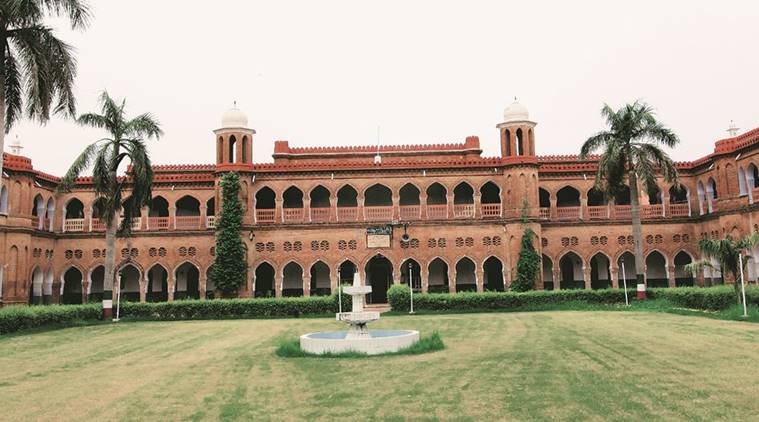
MILLIONS of AMU students and alumni around the world sing the university tarana every year. It brings back so many Aligarh memories to me and countless others. The tarana itself is a fine piece of Urdu poetry and the story behind it is an interesting one.
One of AMU’s most famous student and an Urdu poet of the highest calibre, Asrar-ul-Haq Majaz, attended the university between 1930 and 1936.2 It was 1936 that he penned his famous poem Nazr-e-Aligarh.1 Majaz first recited it the same year in the Union Hall, in the presence of the Pro-Vice Chancellor (PVC) A.B. Ahmed Haleem.
Haleem stopped the recital and walked out when Majaz reached the lines “YahaaN ham ne kamandeN daalii haiN, Yahan hum ney shabkhooN (night raids) maaray haiN; YahaN hum nay qabaayeN nochii haiN, yahan hum nay taaj utaarey haiN” (Trans: We have scaled buildings here and ambushed here, We have torn garments here and removed crowns here).4
The huge gathering of students asked him to continue but Majaz did not. He had to relent later, and completed it in the Union Hall’s lawns (between Morrison court and Union building).3
Although Majaz left the university campus, his poetry continued to influence students. Ishtiaque Ahmad Khan, a B. Ed student (1954-55) was also one such person. An address by the VC, Dr Zakir Husain, to the final year students inspired Khan to do something long-lasting for the university. He thought of putting Majaz’s Nazr-e-Aligarh to tune and was confident of it becoming the university song.1
Khan created the tune in the last week of September, 1954, and requested the President of the Union, Ahmad Saeed, for his permission to present it to the university. He refused angrily on hearing the poet’s name – Majaz being a progressive writer. But, the VC agreed and even acknowledged that it was one of Majaz’s better works.1
It was October 17th, 1954, when Ishtiaque Ahmad Khan walked to the dais in the Stretchy Hall along with his troupe (Saleh Naiyyar, Ghulam Haider Ejaz and Fasih). Izzat Yaar Khan, Secretary of SS Hall Music Club, started the tune on the harmonium and soon the hall was reverberating with the sound of “Ye mera chaman…” The VC was impressed. Even Saeed appreciated the poem and apologised to Ishtiaque about his stand earlier.1
And so the Aligarh tarana came into being. Majaz died a year after it was first played.2 A poetic justice indeed!
Dr Sami Rafiq (Professor in the Department of English, AMU) translated the tarana into English, in 2014, as part of her book Aahung.
The Full Tarana in Roman Script
Ye mera chaman hai mera chaman, main apne chaman ka bulbul huṅ
Sarshaar-e-nigaah-e-nargis huṅ, paabasta-e-gesoo-e sumbul huṅ
Ye mera chaman, ye mera chaman, Ye mera chaman hai mera chaman,
main apne chaman ka bulbul huṅ!
Jo taaq-e-haram mein roshan hai woh shama yahan bhi jalti hai,
Iss dasht ke goshey goshey se ik jooy-e-hayat ubalti hai
Ye dasht-e-junuṅ deewanoṅ ka, ye bazm-e-wafaa parwanoṅ ki
Ye shehr-e-tarab roomanoṅ ka, ye khuld-e-bareeṅ armaanoṅ ki
Fitrat ne sikhayee hai humko uftaad yahaṅ parwaaz yahaṅ
Gaaye haiṅ wafaa ke geet yahaṅ, chheda hai junuṅ ka saaz yahaṅ
Ye mera chaman hai mera chaman, main apne chaman ka bulbul huṅ!
Iss bazm mein tegheiṅ khiṅchiṅ hain, is bazm mein saaḡar todey haiṅ
Iss bazm mein aankh bichhaayee hai, iss bazm mein dil tak jodey haiṅ
Har sham hai shaam-e-Misr yahaṅ, har shab hai shab-e Shiraz yahaṅ
Hai saarey jahaṅ ka soz yahaṅ aur saarey jahaṅ ka saaz yahaṅ
Zarraat ka bosa lene ko sau baar jhuka aakaash yahaṅ
Khud aaṅkh se hamne dekhi hai baatil ki shikast-e-faash yahaṅ
Ye mera chaman hai mera chaman, main apne chaman ka bulbul huṅ!
Jo abr yahaṅ se utthega, wo sarey jahaṅ par barsega
Har jooy-e-rawaaṅ par barsega, har koh-e-garaaṅ par barsega
Har sarw-o-saman par barsega, har dasht-o-daman par barsega
Khud apne chaman par barsega, gairoṅ ke chaman par barsega
Har shahr-e-tarab par garjega, har qasr-e-tarab par kadkega
Ye abr hamesha barsa hai, ye abr hamesha barsega
Ye abr hamesha barsa hai, ye abr hamesha barsega
Ye abr hamesha barsa hai, ye abr hamesha barsega
Barsega, barsega, barsega!
NOTES
1 Dr Rahat Abrar, Muslim University Ki Kahani, Farzandan-e-Aligarh Ki Zabani (Aligarh: Alisha Publications Pvt Ltd, 2015), 319-328.
2 “Asrar-ul-Haq Majaz – A Journey of Love, Hope and Nationalism”, accessed October 21, 2017, http://theothernews.in/index.php?option=com_content&view=article&id=8699:asrar-ul-haq-majaz-a-journey-of-love-hope-and-nationalism-&catid=44:literary&Itemid=304.
3 Ainel Jafari, Facebook comment, October 18, 2017.
4 Dr Sami Rafiq, Aahung: Poems by Asrarul Haq Majaz Translated into English (New Delhi: AuthorsPress, 2014).91-93.
A beautiful AMU Struggle Taraana also is written over the present and a never-ending condition surrounding Aligarh Muslim University.
For my Alma mater – My chaman and the nourishing and bountiful mother. We are together in our struggle and demands in the most democratic, constitutional and ethical ways. We are together to resist the efforts of keeping our educational institutions blazed in the flames of evil designed communal politics. We are together to help develop compassion in the society, end oppression and win accolades for our nation India.
jai Hind.
https://www.youtube.com/watch?v=byX3dRXBfUQ